One of the interesting style developments at the 2012 Chelsea Flower Show was the "new English" style of planting that we saw in show gardens such as the M&G Investments Garden by Andy Sturgeon. This new style has roots in the Arts and Crafts gardens that were so popular in the early part of the last century.
The new English style has a traditional cottage garden feel but a fresher look. It uses familiar components of the original Arts and Crafts garden — linear paths, terraces, tall and clipped hedges backing wide herbaceous borders and bold topiary — but gives it a modern twist. The plantings have moved away from the meadow style that gained influence over the last decade and toward voluptuous borders with repetitive clumps of perennials that soften the outlines of paths and walls.
The Arts and Crafts movement was championed by brothers Charles and Henry Greene in America, while here in Britain, Gertrude Jekyll was its best-known advocate. The movement was not long lived, but there is no doubt that it has greatly influenced garden design not only Britain, but also in America and beyond.
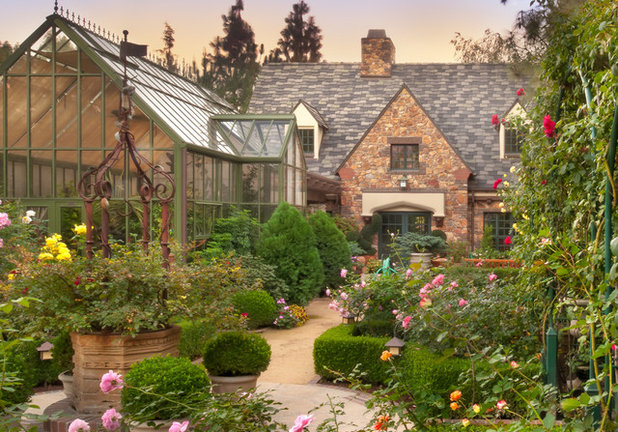
HartmanBaldwin Design/Build
Integrating the house with the garden. For the first time in garden design history, Arts and Crafts integrated the house with the garden. Design features in the house were reflected in the garden and vice versa.
The Arts and Crafts style, especially in the gardens of Gertrude Jekyll and Edwin Lutyens, who were at the forefront of the movement in the late 19th century and early 20th century in England, is characterized by the use of traditional materials and working methods that lead to an organic completeness of the design.
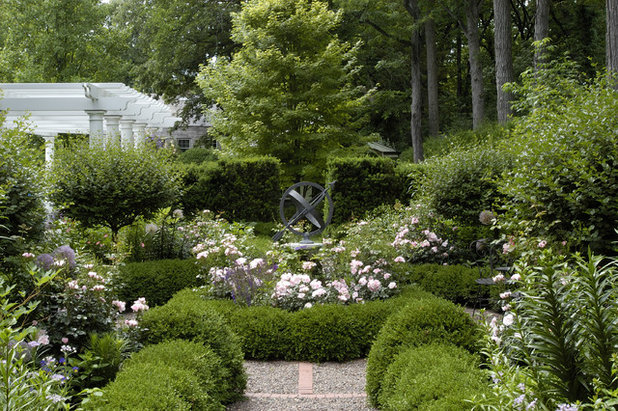
Schmechtig Landscapes
The birth of the garden room. The movement introduced the creation of separate garden rooms, giving each part of the garden a different feel.
The great British gardens of this era — at Hidcote Manor, Sissinghurst and Great Dixter — all have partitioned areas of the larger garden that have different planting schemes, ornamentals, water features or hard landscaping.
One of the most stunning planting ideas championed by the Arts and Crafts designers was the use of monochromatic plantings, with white gardens being the favorite.
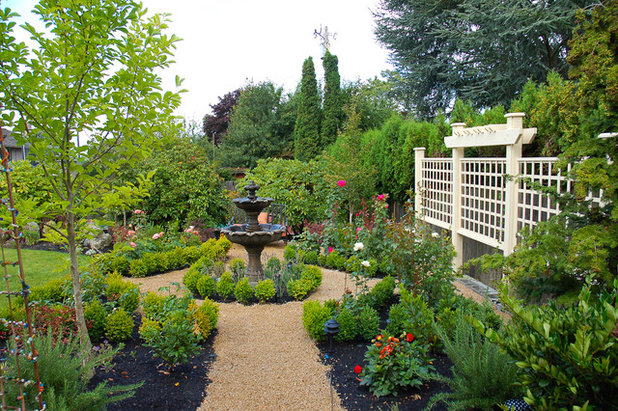
Paul Moon Design
The British Arts and Crafts movement grew out of contempt for the restricting philosophies of Victorian garden design. Geometric bedding plant schemes, winding paths and exotic plants were replaced by an interest in nostalgic ideals from medieval times and a return to regionalism and craftmanship.
This small formal area in a larger garden echoes the formal side of the movement's designs, with ideas taken from knot gardens and parterres used in medieval gardens. Well-placed ornaments, such as this two-tiered bowl fountain that complements rather than overshadows the room, were favorite embellishments.
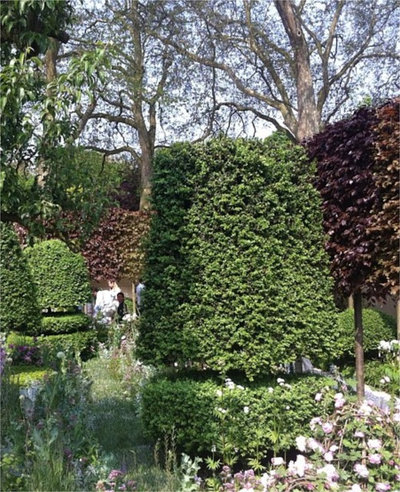 The return of topiary.
The return of topiary. The garden rooms were created by enclosing areas with walls or, more usually, hedging. The movement gave impetus to the planting of traditional hedging such as yew
(Taxus baccata) and boxwood (
Buxus sp). This use of hedging also brought the return of topiary.
Topiary, having fallen out of favor for the best part of a hundred years, was resurrected by the Arts and Crafts movement.
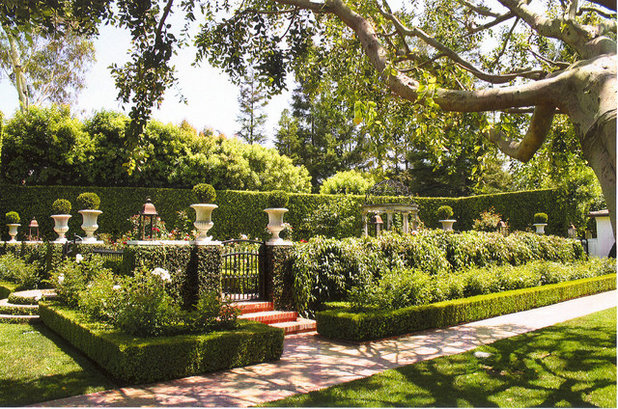
Susan Cohen Associates, Inc.
This modern garden shows the amazing use of hedges of different species and heights, from the low boxwood
-bed edging to the tall formal enclosing hedges.
Its design has its roots in Edwardian gardens, where the strong lines of enclosing hedges and walls were softened by naturalistic plantings that were allowed to overspill their boundaries.
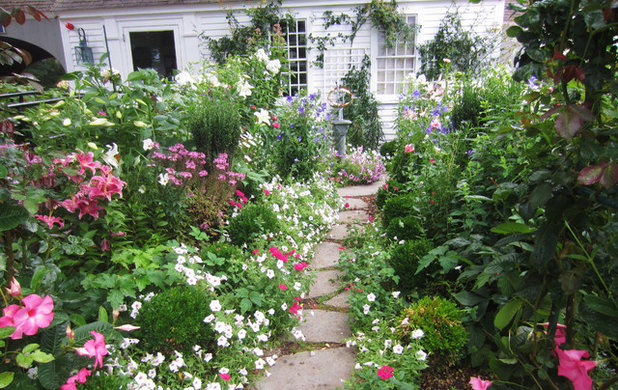
Maria Hickey & Associates Landscapes
The flair of cottage garden planting. Planting schemes moved away from Victorian restrictions and turned to a more naturalistic or cottage garden style. These plantings related to the site and soil conditions, the local identity and how the plants grew naturally.
Plants were grown in drifts and allowed to spill over paths and edging, with little obvious control. This look is the image most people have of a traditional English country garden.
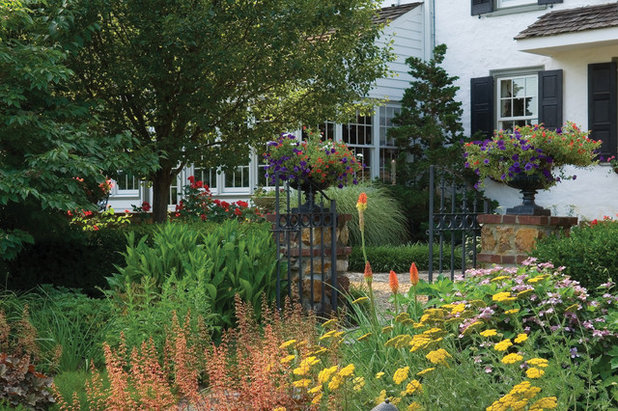
Wallace Landscape Associates
In the tapestry style of planting, drifts of perennial plants were interwoven, giving months of color from early spring to late autumn. These were very effective but also very labor intensive. A large amount of staking and creating support for the larger species was required, as well as splitting and replanting plants regularly to keep them vigorous and flowering well.
Today we can create the same effect without all the work by using modern dwarf or self-supporting varieties that don't need a lot of maintenance.
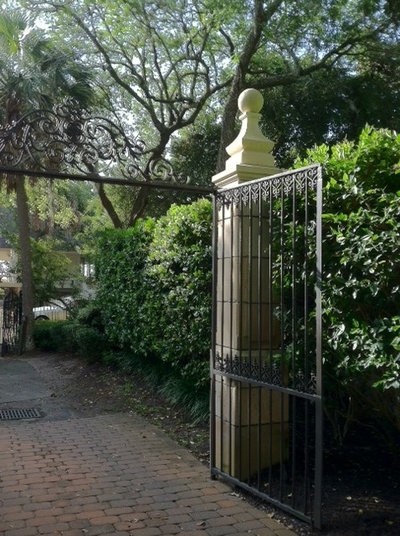
Leo Dowell Designs
The use of claires-voies. Though normally found in gardens of the 17th century, the
claire-voie ("clear way") was also found in some Arts and Crafts gardens. A
claire-voie is an openwork gate or fence set at the end of an allée, or open walk, with a view out to a wilder part of the garden or landscape.
There are two fine examples in Lawrence Johnson's Hidcote Manor garden. One is at the end of a beech-lined
(Fagus sylvatica) allée, and one leads to the open Cotswold countryside from the end of a pleached hornbeam
(Carpinus betulus) walk.
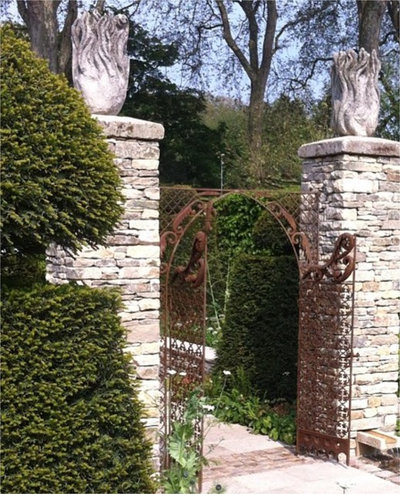
David Ward
A great example of a
claire-voie was seen at the 2012 Chelsea Flower Show in Cleve West's Brewin Dolphin Garden. Ornamental gates between rustic stone pillars led the eye through to a traditional garden room behind.
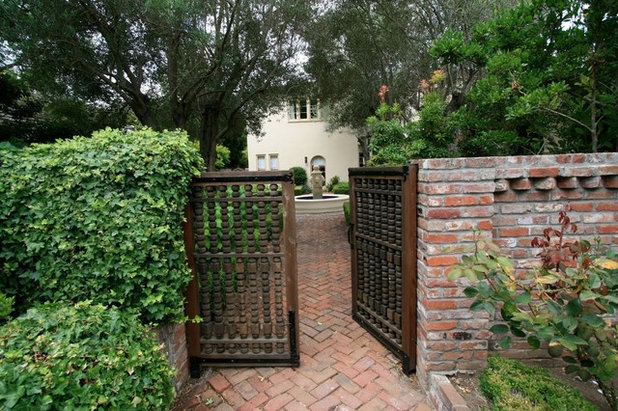 Celebrating local materials.
Celebrating local materials. The principles of using local materials and hand crafting led to the popularization of brick paving. Locally made bricks can be found in many of the original Arts and Crafts gardens, where they usually mirror the brickwork found in the adjoining house.
Herringbone and basket weave designs were the most commonly used in paths, as seen in this beautiful example, where the same bricks are used in the wall as well.
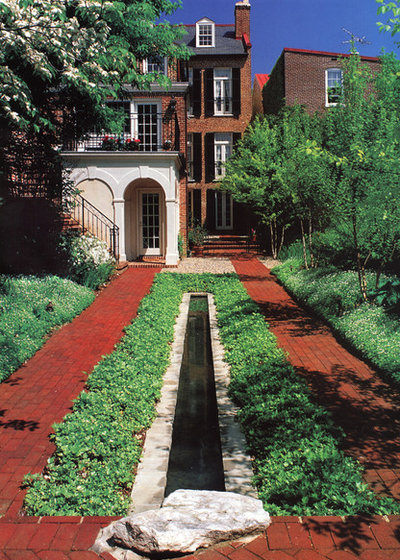
Samuel H. Williamson Associates
This modern back garden design also uses brick paving, but this time it surrounds another favorite feature of Arts and Crafts designers — the rill. Water features in Arts and Crafts gardens tended to be gentle and understated. Linear paths and terraces were combined with mirrored water channels or rills.





